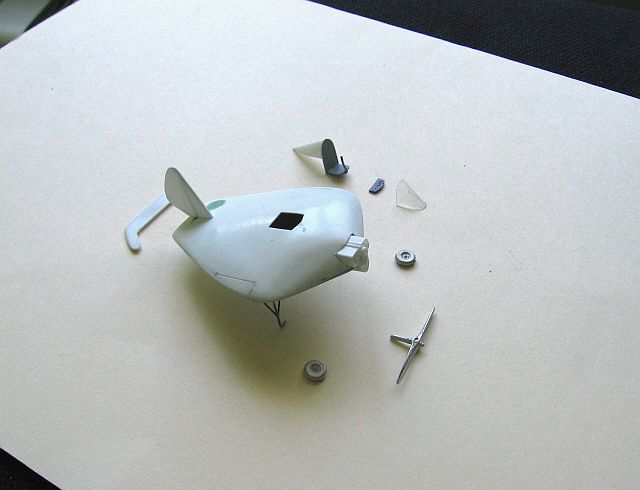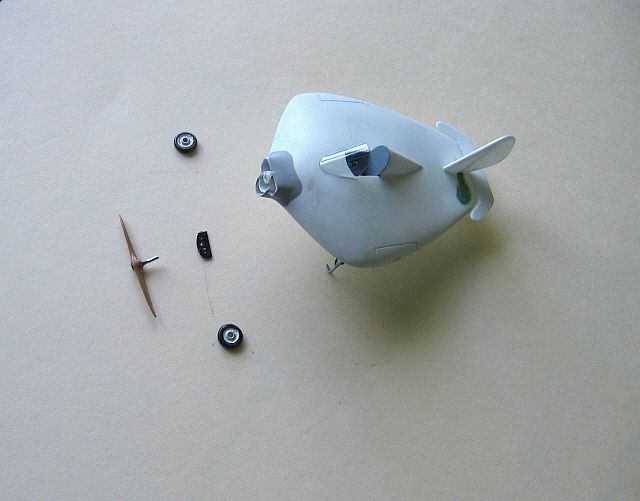
Scratch-built 1/72 Eshelman Flying Flounder
By Gabriel Stern
 As many of you do, I like to alternate more complex projects with simple ones.
As many of you do, I like to alternate more complex projects with simple ones.
Again, as many of you do, I many times discover that simple projects simply don’t exist.
 Anyway, I call the long-hauling, all-demanding projects the “405” projects. For those who live in the L.A. area further explanations are not needed. I can hear you already weeping. For the non familiar with the denomination, this main L.A. freeway has been under “improvement” for the last 2,798 years.
Anyway, I call the long-hauling, all-demanding projects the “405” projects. For those who live in the L.A. area further explanations are not needed. I can hear you already weeping. For the non familiar with the denomination, this main L.A. freeway has been under “improvement” for the last 2,798 years.
 Meanwhile, the already jamming-prone L.A. traffic suffers the consequences of the “improvement”. As we snazzy Angelenos once more take the 405 to our destinations, we see the closed lanes that run for miles and miles, we see the trucks, the concrete dividers, excavations that run to the center of the earth, all kinds of construction paraphernalia like a giant “Playmobil” set. But what we do not see is the improvement.
Meanwhile, the already jamming-prone L.A. traffic suffers the consequences of the “improvement”. As we snazzy Angelenos once more take the 405 to our destinations, we see the closed lanes that run for miles and miles, we see the trucks, the concrete dividers, excavations that run to the center of the earth, all kinds of construction paraphernalia like a giant “Playmobil” set. But what we do not see is the improvement.
 As we all know, by the time it is done – if it’s even going to be done - new “improvements” are surely going to be needed. But we can confidently leave that to the next generations, since I lost any hope of seeing its completion during my life time. Even if I live, as I plan, for the next 300 years.
As we all know, by the time it is done – if it’s even going to be done - new “improvements” are surely going to be needed. But we can confidently leave that to the next generations, since I lost any hope of seeing its completion during my life time. Even if I live, as I plan, for the next 300 years.
So, between “405” projects I take some rest building little things like the hereby presented Eshelman Flying Flounder. Once you look at it the name becomes obvious, and I hope you don’t smell anything fishy. And yes again, it did fly.
 The ones familiar with these articles know that I usually favor either “Pioneer” or “Golden Era” projects, but sometimes creatures outside this time envelope (1941 in this case) are just too good to be missed.
The ones familiar with these articles know that I usually favor either “Pioneer” or “Golden Era” projects, but sometimes creatures outside this time envelope (1941 in this case) are just too good to be missed.
Not much is around in terms of data. A note in Aerofiles –bless it- and the above-mentioned Youtube clip. So you all know, span is speculative at 3.45 meters, and so is the color. The added walkway is visible in the clip. So is the antenna wire.
 Mr. Eshelman was quite a character, and I’ll leave it to you to discover details of his adventurous life. Be only said here that he was equally comfortable designing planes, toys, boats and many things more.
Mr. Eshelman was quite a character, and I’ll leave it to you to discover details of his adventurous life. Be only said here that he was equally comfortable designing planes, toys, boats and many things more.
The model itself was solved with the usual master and vac parts done in my magical Mattel contraption. To that core only a few details needed to be added: elevator, rudder, turtledeck, cockpit, instrument panel, windshield and the parts associated with the landing gear and engine.
 Once you are happy and sure you have safely arrived to the completion of the model, you realize you have to make the decals. White decals, none the less. To the rescue came fellow modeler Esteban the Arizonio, who also included in the padded envelope a crayfish that I managed to train to hold parts while they are drying. Thanks, Esteban! The circles on the fin read in black letters on white background “Eshelman – USA”.
Once you are happy and sure you have safely arrived to the completion of the model, you realize you have to make the decals. White decals, none the less. To the rescue came fellow modeler Esteban the Arizonio, who also included in the padded envelope a crayfish that I managed to train to hold parts while they are drying. Thanks, Esteban! The circles on the fin read in black letters on white background “Eshelman – USA”.
Now, is it a flying wing or a lifting body? Or perhaps a flying fish?









